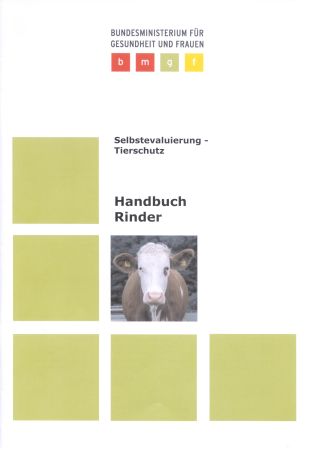As part of a project carried out on behalf of the Federal Ministry of Health and Women in agreement with the Federal Ministry of Agriculture, Forestry, Environment and Water Management, checklists and manuals for self-evaluation of animal welfare for cattle, sheep and cattle were developed under the direction of the HBLFA Raumberg-Gumpenstein Goat farming developed. Manuals and checklists for pig and poultry farming were created under the direction of the University of Veterinary Medicine Vienna. The checklists and manuals offer every farmer the opportunity to check his stable point by point for compliance with Austrian animal protection law. They provide the veterinarian and consultant with a detailed interpretation document on the applicable animal welfare regulations.
The checklist covers all points of animal protection law, which are presented in simplified text with yes/no answers. A short explanatory text with examples and sketches, which is attached to the page opposite the questions in the brochure, serves as an aid to filling out the questionnaire. In accordance with the manual, the checklist is divided into seven areas of influence (A - G):
- A possibility of movement
- B social contact
- C Air, light, noise
- D Drinking & feeding
- E care
- F interventions
- G Keeping outdoors all year round (for cattle and sheep) or predominantly keeping outdoors (for goats)
Within the areas of influence, the questions are numbered consecutively. The checklist is structured according to the main areas of use common in cattle, sheep and goat farming:
- Cattle: dairy cows, young cattle, calves, fattening cattle, mother cows with calves, breeding bulls
- Sheep: dairy sheep, ewes, young sheep, lambs, rams
- Goat: dairy goats, mother goats, young goats, fawns, rams
This makes it possible to check the entire stable with just one checklist. The Austrian Animal Welfare Act provides for transition periods of varying lengths depending on the extent of the adaptation measure for the implementation of livestock welfare provisions. These transitional provisions are also clearly visible in the checklist.
The manual provides detailed additions and explanations to the checklist. It describes the interpretation of the legal text, the assessment method, provides background information on the meaning of the individual provisions and gives further recommendations on animal-friendly design of the stable.
For quick orientation, the respective area of influence (e.g. soil conditions) can be read in the header of each manual page. At the end of the manual there is a glossary that provides the necessary definitions.
The manual is structured as follows:
- Question from the checklist (with consecutive numbering)
- Legal norm: represents the relevant legal basis from TSchG and ThVO
- Survey: describes the measurement or survey methodology
- "Completed if": describes which criteria must be met so that the question can be answered with "yes".
- Recommendation: provides information that goes beyond the legal minimum in order to make the husbandry system more animal-friendly. This valuable chapter makes the handbook more than just a legal interpretation tool. It offers a well-founded reference work for all animal husbandry questions.
- Meaning: explains the importance for the health and behavior of the animal
- Transition period (for cattle) or implementation (for sheep and goats): based on the legally provided transitional provisions, describes when a provision must be complied with at the latest.
The animal welfare self-evaluation project is offered in collaboration with the Austrian Animal Health Service (TGD), the chambers of agriculture, and the state control and breeding associations. The checklists and manuals are available both in paper form and on CD.
You can find all checklists and manuals under the link below to the Department for Animal-Friendly Animal Husbandry and Animal Welfare!







